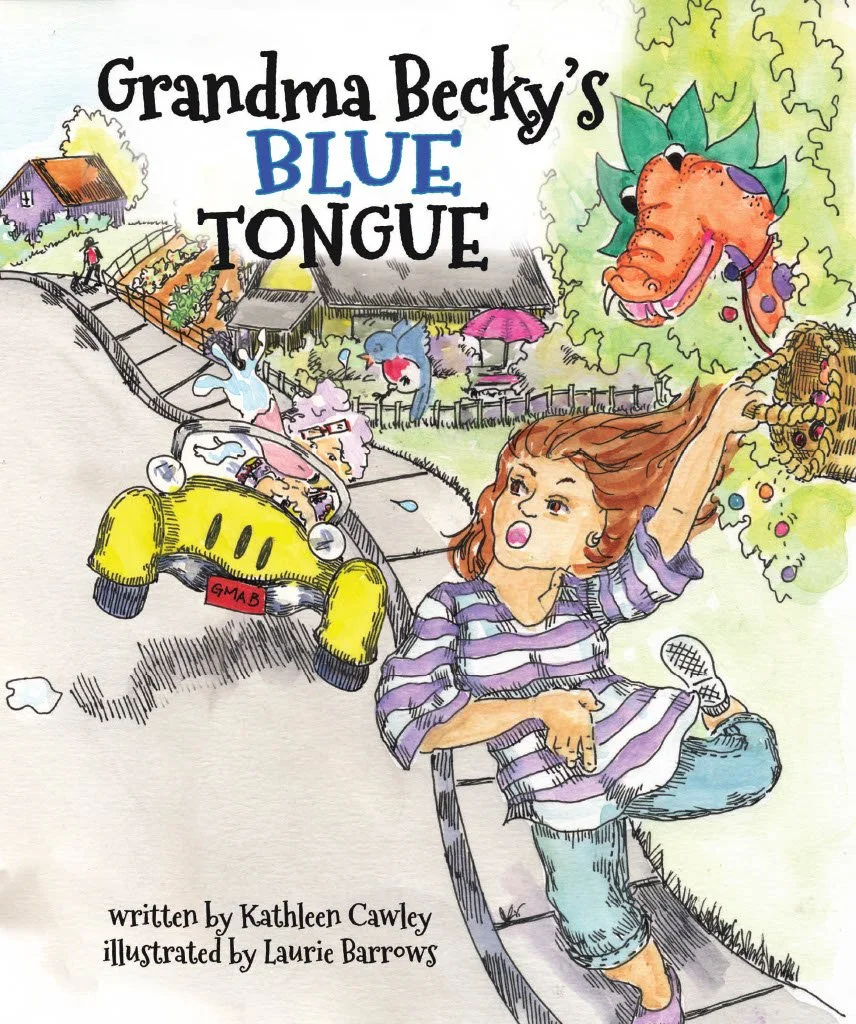Parenthood is an emotional whirlwind of sublime joy and tooth grinding frustration. Find laughter, research, and perspective in Navigating the Shock of Parenthood.
Kathleen also writes wild and wacky children’s picture books. First in her series is Grandma Becky’s Blue Tongue. Why has Grandma’s tongue turned blue, and what kind of creature is she becoming?! Are those tentacles? And, what is a Fleep?! This fantastic read aloud is full of amazing illustrations and silly alliterations. Kids 5-10 will love this adventure!
Kathleen Cawley, PA-C
Kathleen Cawley is a 58 year old mother to 13 year old boy-girl twins, a physician assistant who has practiced pediatric and adult medicine for 18 years and a writer. Having fled the cool, crowded, chaos of the SF bay area for the unrelenting heat of the Sacramento summer sun, she is currently a work-at-home-mom.
Her first book, Navigating the Shock of Parenthood: Warty Truths and Modern Practicalities-from a mom with twins, discusses the emotional challenges of new parenthood, the social and political evolution of American parenting, and some of the more rarely discussed aspects of raising wild beasties.
Navigating Mini-books
Helping parents over modern hurdles.
Also by Kathleen

Learning Differences: Differences or Disabilities?
The first thing you need to know about learning differences is they are truly often differences and not disabilities.
The list of brilliant people who struggled with these so called learning disabilities is huge. Really, really, HUGE! Steve Jobs, Michael Phelps, Whoopi Goldberg, Steven Spielberg, Jammie Oliver, Charles Schwab, Richard Branson, Anderson Cooper, Magic Johnson, Agatha Christie…on and on the list of great minds goes. Each of them labeled with dyslexia or dys-whatever-ia.
Research has shown that people with dyslexia actually excel at certain kinds of reasoning. Unfortunately, our educational system remains in the dark ages.
Most of your child’s teachers, principals, and counselors generally have had no, none, nada bitta education on how “atypical” kids learn. They probably have no course work or training in the neurobiological development of a child’s brain. None. Which is quite a bummer.
One in five kids has dyslexia! That’s 20% of the population! If you have two kids and your best friend has three kids, then the chances are good that one of them may be dyslexic. If you or your partner had any trouble learning to read, then there’s an even higher chance of dyslexia in your children. And that’s just dyslexia.
There’s also dysgraphia, dyscalculia, slow processing, working memory impairments, executive function challenges, and many others.
This means that more, much more, than one-fifth of the school age population has a neurobiologically different way of learning, and most of our teachers have no training in how to identify or teach these kids.
Furthermore, for much of our educational system, the politics of “what” to teach the masses takes priority over “how” to teach the huge diversity of different brains sitting in our classrooms.
What exactly is a neurobiological learning difference? Imagine your brain as a mass of interconnected train tracks. If you have a “neurotypical” brain then you have a smooth, well-used track that runs from Sacramento to Los Angeles. It’s easy, and fast for you to send a signal from one to the other.
A child whose brain is neurologically different may not have any direct connection from Sacramento to LA. If this child wants to convey a message from Sacramento to LA, they may need to send a train to Chicago! Once in the Chicago train yards, that train may get sent to LA or it may get rerouted to Seattle!
If the neurons in your brain are laid down differently or connected differently, then you can only use them the way they are currently laid down. That’s a neurobiological difference that affects how a child learns and thinks and behaves.
If a child has an unusual arrangement of brain train tracks, it doesn’t mean they can’t learn. It just means they need to learn and communicate in a different way. This is what is called a “learning disability.”
However, it is often actually a teaching disability. The kid can learn if we know how to teach them.
The laying down and revising of all these neural brain connections is an ongoing process from birth to mid-twenties. It starts with massive over connections that are then pruned away to faster and more efficient linkages. Everyone’s brain evolves at its own rate and in its own timeline.
That’s what’s sitting in a classroom of thirty plus kids and one under informed teacher with little to no school district support.
The neurobiological science on learning differences is steadily growing. We now have functional MRI’s that can give us insight into how each individual’s brain works. This has taught us so much about children with learning differences and how to effectively teach them.
Unfortunately, our entire educational complex is so far behind as to be virtually unaware of the science. This means that if your child has one of these learning differences, then you need to become a strong, informed, and vocal advocate for your child.
This is challenging, time consuming, and often highly emotional. In the next series of articles I will offer an overview for parents of the more common learning differences. I’ll go over some early signs you might see in your child if they process things differently. This is not remotely comprehensive. I provide it as a launching off point for questions and investigation.
MY BOOK IS PUBLISHED! TAKE A LOOK!
Kathleen Cawley is a physician assistant and author. She is a regular guest columnist for the Auburn Journal where she writes on parenting and childhood. Her book, Navigating the Shock of Parenthood: Warty Truths and Modern Practicalities — from a mom with twins, is available where books are sold. Coming soon, Grandma Becky’s Blue Tongue, a children’s picture book.









